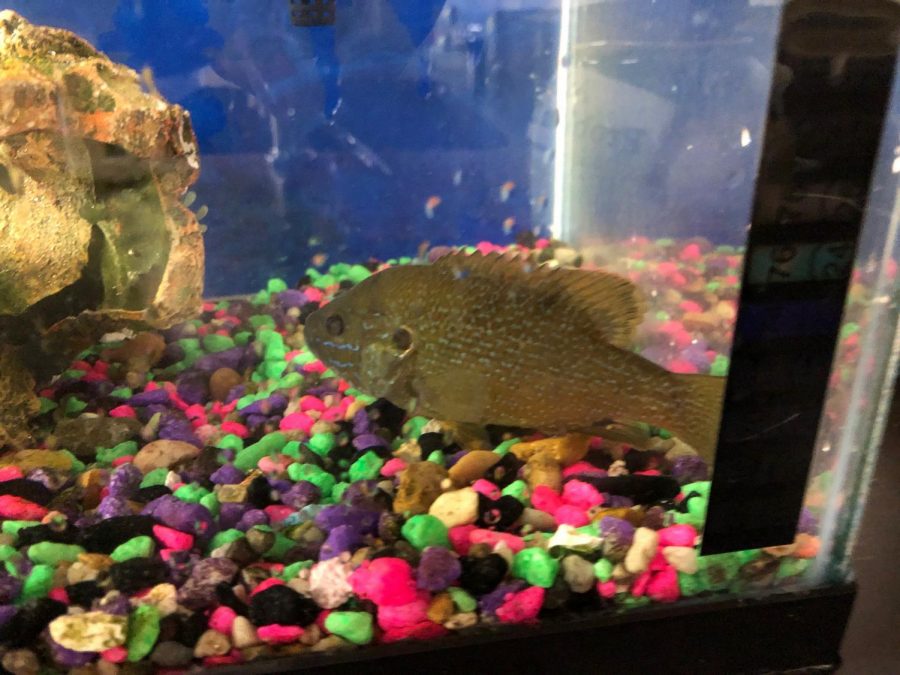Finding Nemo in a bathroom sink?
Fish rescued from world language restroom dies
This fish was found swimming in a clogged world language bathroom sink before it was transferred to a tank by marine biology teacher Doug Mason. The fish died shortly after.
The world language building men’s bathroom is home to many surprises, from urine-soaked floors to soggy paper towels delicately arranged on the ground.
But assistant principal Tucker Farrar couldn’t have expected to find what he did on Aug. 20 when he walked in and saw a 5-to-6-inch fish swimming around in a clogged-up sink, presumably put there by a student. The fish died later that day, near the end of sixth period.
“I was surprised,” Farrar said. “I was so shocked it was so big. When someone said there was a fish in the sink I thought it would be goldfish sized.”
The students and teachers who found out about the fish before it died were stunned about the incident.
“I thought it was pretty unnormal (sic) to see a fish transferred from its habitat into a sink in a school bathroom,” said sophomore Jayden Pereira, who heard about the fish in teacher Douglas Mason’s sixth period marine biology class.
While walking around the quad at lunch the same day, Farrar overheard chatter from students about fish in the bathroom. Farrar decided to investigate afterwards.
“They were very excited,” Farrar said.
After finding the fish, Farrar asked Mason to accompany him to collect it from the sink. When they arrived, Mason found the fish swimming in the sink and caught it with a net and beaker.
After Mason returned to his classroom, he borrowed a roughly 20-gallon tank supplied by principles of biomedical sciences teacher Joanna Condon.
“I thought it was funny, and also sad because the fish probably wouldn’t have died if the kid did not pull the prank,” Condon said.
Mason tried to look for a chemical that could remove chlorine and chloramines from the tap water he used to fill the tank, because chlorine is harmful to fish. But he couldn’t find any chemical that worked.
Even though Mason couldn’t find dechlorinating chemicals, he put the fish in the tank anyway. Mason said getting the fish oxygen was more important than removing the chlorine.
When the fish was first placed in the tank, it swam around and went to the top to get air, Mason said. Mason put in an air stone, which diffuses air into the water, to provide the fish with more oxygen.
Over the course of the next hour and a half, however, the fish stopped swimming to the top and appeared ill.
“I was teaching a class, so I wasn’t watching him every second, but every time I checked in on him you could see some deterioration, you could see he was on his side, he sat on the bottom,” Mason said.
Then, the fish died.
“I think it was a cumulation of stress and the fact that we couldn’t get the chlorine and chloramines out of the water,” Mason said.
There is ambiguity amongst students and teachers about what species of fish was found in the sink that fateful Friday. Mason believed it was a fish in the cichlid family.
But Pereira, who studies freshwater fauna in his free time, has other thoughts.
“The fish was a freshwater warmouth. The warmouth is part of the bass and bluegill family,” Pereira said. “I’m guessing someone brought a fishing pole and caught one of these fish [in South San Ramon Creek, behind Cal High] and brought him alive and put him in the bathroom sink at our school.”
Before the fish died, Farrar tried to find a permanent home for it by emailing staff and asking if anyone wanted to adopt the fish, assuming it didn’t die.

Senior Nicholas Harvey is the Editor-in-Chief for The Californian. Writing for the paper since freshman year, Nicholas is especially interested in the...









